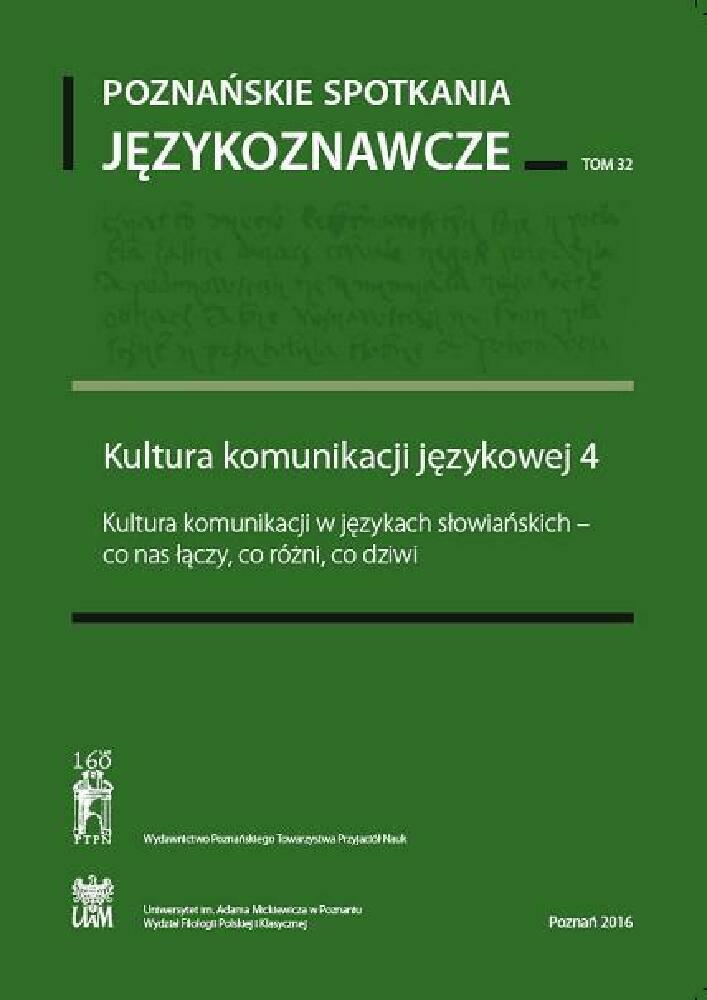Abstract
Intertextual references as a game suggested by the author and played by the Internet user, contribute to the process of creating and receiving online memes. In their case this intertextual game is more complicated than in traditional literary texts as it refers to different sign systems: iconic and verbal. Frequently on top of referring to online memes the process of discovering intertextual relations necessitates uncovering textual references from outside the Internet. The author focuses on the mechanisms of this intertextual game within specific types of memes. The mechanisms are presented on the basis of a study of one meme series. For intertextual reception of a meme, the clues for the receiver are both on the iconic level (by repeating the iconic element or a part of it) as well as on the level of the verbal text (by repeating the syntactic structures), e.g. questions, parallel structures, an innovative use of the language which involves new morphological and inflectional formations (the use of neologisms and inflectional forms which are not used by native speakers), distortions of the phonetics and spelling which lead to a noticeable formal similarity between the newly created text and the text (or its fragments) to which the intertextual reference is made.
References
Blackmore S., 2004, Maszyna memowa, przeł. N. Radomski, Poznań.
Borkowski W., Nowak A., 2005, Wpływ społeczny jako model rozprzestrzeniania się memów, „Teksty z Ulicy. Zeszyt Memetyczny” nr 9, s. 44–68, http://www.memetyka.us.edu.pl/dokumenty/pliki/zm09_2005_BORKOWSKI&NOWAK.pdf [dostęp: 12.02.2015].
Dawkins R., 1996, Samolubny gen, przeł. M. Skoneczny, Warszawa.
Fiołek-Lubczyńska B., 2012, Intertekstualność i gatunkowość jako klucz interpretacyjny filmu Trzy kolory. Biały Krzysztofa Kieślowskiego, „Folia Litteraria Polonica” 3 (17), s. 205–219, http://dspace.uni.lodz.pl/xmlui/bitstream/handle/11089/2485/Bogumi%C5%82a%20Fio%C5%82ek-Lubczy%C5%84ska.pdf?sequence=1&isAllowed=y [dostęp: 12.02.2015].
Genette G., 1992, Palimpsesty. Literatura drugiego stopnia, przeł. A. Milecki, w: Współczesna teoria badań literackich za granicą. Antologia, red. H. Markiewicz, t. 4, cz. 2, Kraków, s. 107–155.
Głowiński M., 1986, O intertekstualności, „Pamiętnik Literacki” z. 4, s. 77–100.
Kamińska M., 2011, Niecne memy. Dwanaście wykładów o kulturze Internetu, Poznań.
Kołowiecki W., 2012 , Memy internetowe jako nowy język Internetu, “Kultura i Historia” nr 21, http://www.kulturaihistoria.umcs.lublin.pl/archives/3637 [dostęp: 12.02.2015].
Kozłowski T., 2006, Brzytwą po memach. Czy memetycy mnożą byty nad potrzebę?, „Teksty z Ulicy. Zeszyt Memetyczny” nr 10, s. 35–45, http://www.memetyka.us.edu.pl/dokumenty/pliki/zm10_2006_3Kozlowski.pdf [dostęp: 12.02.2015].
Lewandowski P., 2013, Jan Matejk i internetowe memy, czyli kto się śmieje z historii Polski?, http://histmag.org/Jan-Matejko-i-internetowe-memy-czyli-kto-sie-smieje-z-historii-Polski-8342 [dostęp: 12.02.2015].
Łoziński Ł., 2014, Memy – emblematy. Typowy Seba i Typowy Mirek, „Polisemia” nr 1, http://www.polisemia.com.pl/numery-czasopisma/NUMER-12014-12/ukasz-oziski-memy-emblematy-typowy-seba-i-typowy-mirek [dostęp: 12.02.2015].
Markiewicz H., 1984, Odmiany intertekstualności, w: Wymiary dzieła literackiego, red. H. Markiewicz, Kraków, s. 215–238.
Mortas I., 2015, Prawdziwa historia Typowego Mirka. Ujawniamy, kim jest bohater Internetu!, http://tinyurl.com/nowbbd2 [dostęp: 12.02.2015].
Mrowiec M., 2011, Od internetu do memu – ewolucja motywu „człowieka śmiechu” w przestrzeni kultury, „Teksty z Ulicy. Zeszyt Memetyczny” nr 13, s. 53–66, http://www.memetyka.us.edu.pl/dokumenty/pliki/zm13_2011_MROWIEC.pdf [dostęp: 12.02.2015].
Nycz R., 1995, Intertekstualność i jej zakresy, w: idem, Tekstowy świat – poststrukturalizm a wiedza o literaturze, Warszawa, s. 59–82.
Walkiewicz A., 2013, Czym są memy internetowe? Rozważania z perspektywy memetycznej, „Teksty z Ulicy. Zeszyt Memetyczny” nr 14, s. 50–69, http://www.memetyka.us.edu.pl/dokumenty/pliki/zm14_2012_Walkiewicz.pdf [dostęp: 12.02.2015].
Wężowicz-Ziółkowska D., 2005, Skąd się biorą memy? Biologia wobec problemu genezy i ontologii ideosfery, „Teksty z Ulicy. Zeszyt Memetyczny” nr 9, s. 8–24, http://www.memetyka.us.edu.pl/dokumenty/pliki/zm09_2005_ZIOLKOWSKA.pdf [dostęp: 12.02.2015].
Wolek-Kocur B., 2013, Memy internetowe wobec umowy ACTA, „Teksty z Ulicy. Zeszyt Memetyczny”” nr 14, s. 71–80, http://www.memetyka.us.edu.pl/dokumenty/pliki/zm14_2012_Wolek-Kocur.pdf [dostęp: 12.02.2015].
Zaremba M., 2012, Memy internetowe (2010–2011), „Media i Społeczeństwo” nr 2, s. 60–73, http://www.mediaispoleczenstwo.ath.bielsko.pl/art/060_zaremba.pdf [dostęp:12.02.2015].
License
Autorzy
Autorzy tekstów przyjętych do publikacji w czasopiśmie Poznańskie Spotkania Językoznawcze są zobowiązani do wypełnienia, podpisania i odesłania na adres redakcji umowy o udzielenie nieodpłatnej licencji do utworów, z zobowiązaniem do udzielania sublicencji CC.
Zgodnie z umową, autorzy tekstów opublikowanych w czasopiśmie Poznańskie Spotkania Językoznawcze udzielają Uniwersytetowi im. Adama Mickiewicza w Poznaniu niewyłącznej i nieodpłatnej licencji oraz zezwalą na użycie sublicencji Creative Commons Attribution-NoDerivatives 4.0 International (CC BY-ND 4.0).
Autorzy zachowują prawa do dalszego, swobodnego rozporządzania utworem.
Użytkownicy
Zainteresowani użytkownicy internetu uprawnieni są do korzystania z utworów opublikowanych od 2015 r. w Poznańskich Spotkaniach Językoznawczych pod następującymi warunkami:
- uznanie autorstwa - obowiązek podania wraz z rozpowszechnionym utworem, informacji, o autorstwie, tytule, źródle (odnośniki do oryginalnego utworu, DOI) oraz samej licencji;
- bez tworzenia utworów zależnych - utwór musi być zachowany w oryginalnej postaci, nie można bez zgody twórcy rozpowszechniać np. tłumaczeń, opracowań.
Do wszystkich tekstów opublikowanych przed 2015 r. prawa autorskie są zastrzeżone.
Inne
Uniwersytet im. Adama Mickiewicza w Poznaniu zachowuje prawo do czasopisma jako całości (układ, forma graficzna, tytuł, projekt okładki, logo itp.).
